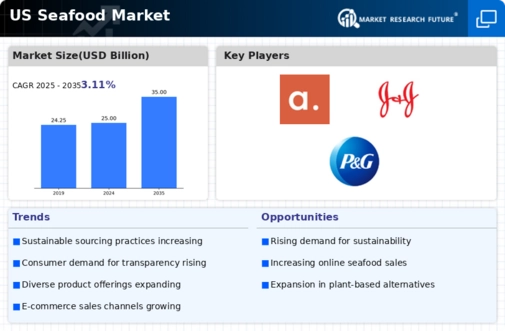Health and Safety Regulations
The meat poultry-seafood-packaging market is heavily influenced by stringent health and safety regulations imposed by government agencies. These regulations are designed to ensure that packaging materials are safe for food contact and do not leach harmful substances into the products. Compliance with these regulations is essential for manufacturers, as non-compliance can lead to significant financial penalties and loss of consumer trust. The market is witnessing a shift towards the use of compliant materials, such as BPA-free plastics and recyclable options, which are expected to account for a larger share of the market. This regulatory landscape is likely to shape the future of the meat poultry-seafood-packaging market, pushing companies to innovate and adapt.
Technological Advancements in Packaging
The meat poultry-seafood-packaging market is benefiting from rapid technological advancements that enhance packaging efficiency and functionality. Innovations such as smart packaging, which incorporates sensors to monitor freshness and quality, are becoming more prevalent. These technologies provide real-time data to consumers and retailers, potentially reducing food waste and improving supply chain management. The integration of such technologies is expected to grow, with estimates suggesting a market expansion of around 8% annually over the next few years. This evolution in packaging technology is likely to redefine consumer experiences and expectations within the meat poultry-seafood-packaging market.
Rising Demand for Freshness Preservation
The meat poultry-seafood-packaging market is experiencing a notable increase in demand for packaging solutions that enhance the preservation of freshness. Consumers are increasingly concerned about the quality and shelf life of meat products, leading to a shift towards advanced packaging technologies. For instance, vacuum packaging and modified atmosphere packaging (MAP) are gaining traction as they significantly extend the shelf life of perishable goods. According to industry reports, the market for MAP is projected to grow at a CAGR of approximately 6.5% over the next five years. This trend indicates a strong consumer preference for products that maintain their freshness, thereby driving innovation in the meat poultry-seafood-packaging market.
E-commerce Growth and Packaging Adaptation
The meat poultry-seafood-packaging market is adapting to the rapid growth of e-commerce, transforming consumer purchasing of food products. With more consumers opting for online grocery shopping, packaging must ensure product integrity during transit. This has led to an increased demand for robust packaging solutions that can withstand shipping conditions while maintaining product quality. Companies are investing in packaging designs that are not only protective but also visually appealing to attract online shoppers. The e-commerce segment is projected to account for a significant share of the meat poultry-seafood-packaging market, indicating a shift in packaging strategies to meet the needs of this evolving retail landscape.
Consumer Preference for Eco-Friendly Packaging
The meat poultry-seafood-packaging market is increasingly influenced by consumer preferences for eco-friendly packaging solutions. As awareness of environmental issues grows, consumers are actively seeking products that utilize sustainable materials. This shift is prompting manufacturers to explore biodegradable and compostable packaging options. Recent surveys indicate that approximately 70% of consumers are willing to pay a premium for products packaged in environmentally friendly materials. This trend not only reflects changing consumer values but also encourages companies to invest in sustainable practices. The meat poultry-seafood-packaging market is likely to see a rise in the adoption of such materials, aligning with broader sustainability goals.














Leave a Comment